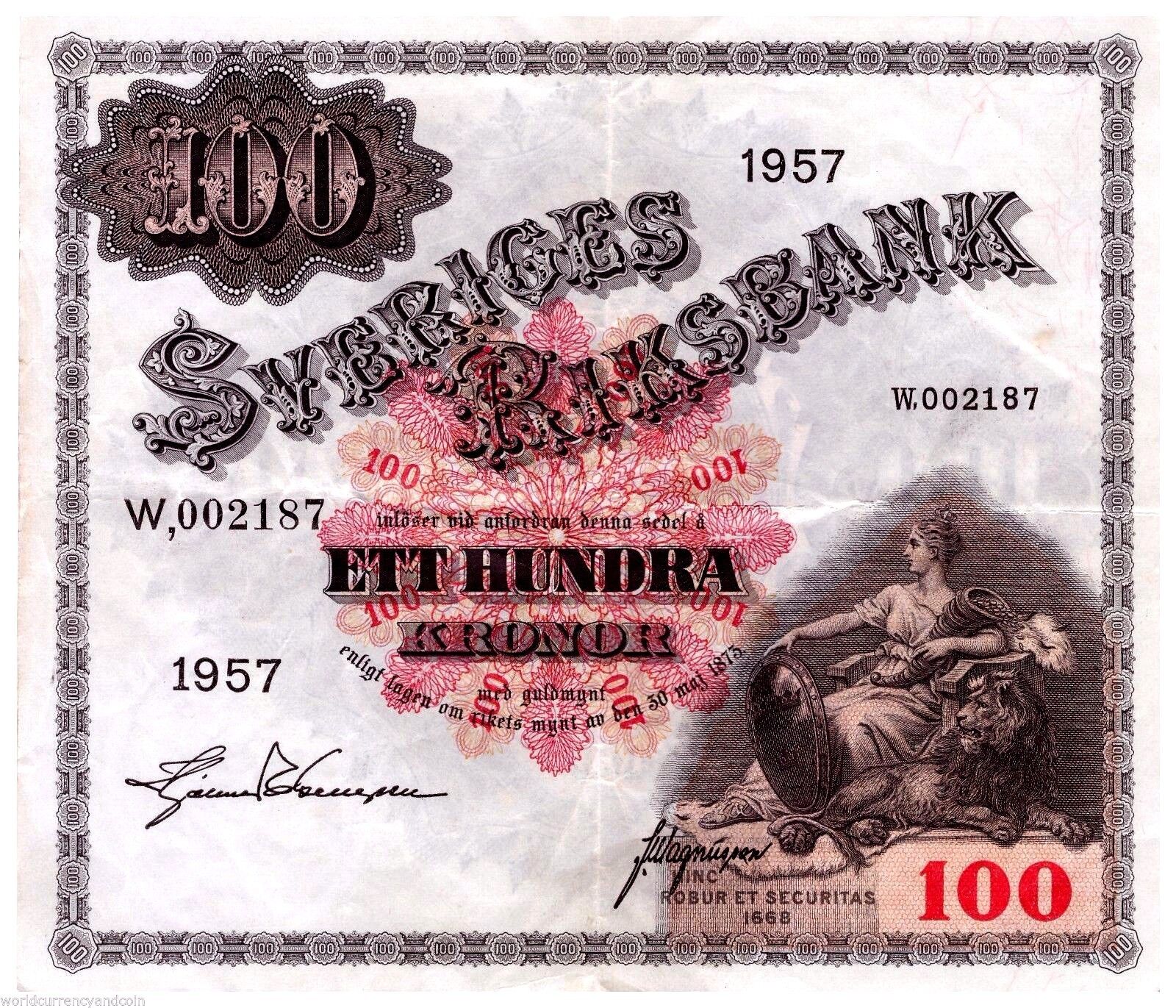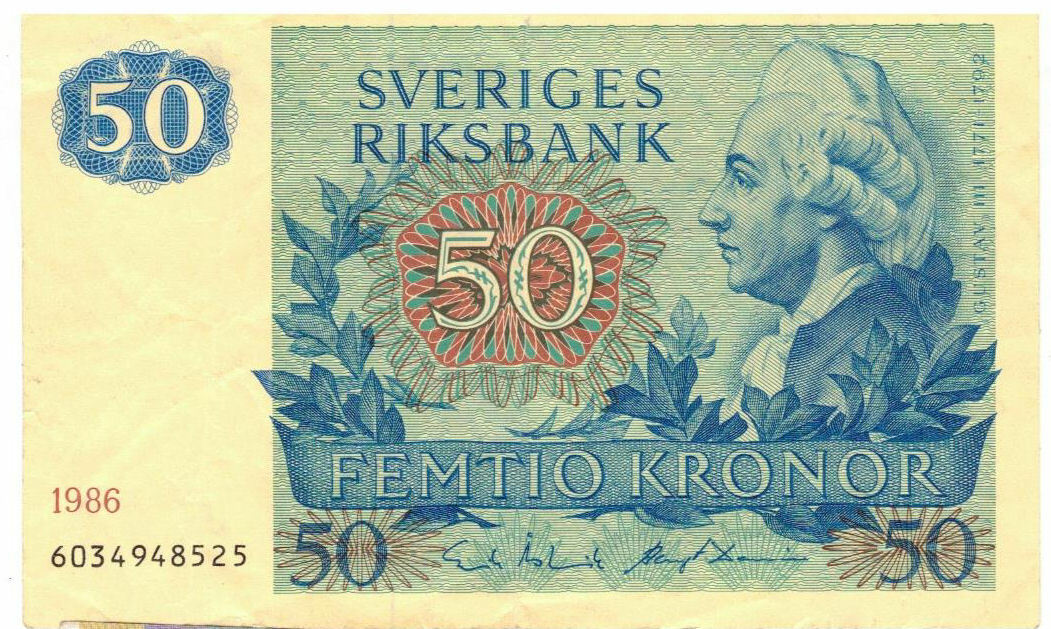-40%
Sweden banknote - 10 kronor - year 1983 - King Gustaf VI Adolf - free shipping
$ 4.75
- Description
- Size Guide
Description
The krona (Swedish; plural: kronor; sign: kr; code: SEK) has been the currency of Sweden since 1873. Both the ISO code "SEK" and currency sign "kr" are in common use; the former precedes or follows the value, the latter usually follows it but, especially in the past, it sometimes preceded the value. In English, the currency is sometimes referred to as the Swedish crown, as krona literally means crown in Swedish. The Swedish krona was the 11th most traded currency in the world by value in April 2013.One krona is subdivided into 100 öre (singular and plural; when referring to the currency unit itself, however, the plural definite form is ören). However, all öre coins have been discontinued as of 30 September 2010. Goods can still be priced in öre, but all sums are rounded to the nearest krona when paying with cash.
History
The introduction of the krona, which replaced at par the riksdaler, was a result of the Scandinavian Monetary Union, which came into effect in 1873 and lasted until World War I. The parties to the union were the Scandinavian countries, where the name was krona in Sweden and krone in Denmark and Norway, which in English literally means "crown". The three currencies were on the gold standard, with the krona/krone defined as 1⁄2480 of a kilogram of pure gold.
After dissolution of the monetary union in August 1914, Sweden, Denmark, and Norway all decided to keep the names of their respective and now separate currencies.
In 1874, notes were introduced by the Riksbank in denominations of 1 krona and 5, 10, 50, 100 and 1000 kronor. The 1 krona was only initially issued for two years, although it reappeared between 1914 and 1920. In 1939 and 1958, 10,000 kronor notes were issued.
Production of the 5 kronor note ceased in 1981, although a coin had been issued since 1972. With the introduction of a 10 kronor coin in 1991, production of 10 kronor notes ceased and a 20 kronor note was introduced.
All remaining 1-krona banknotes became invalid after 31 December 1987. All remaining 5-kronor and 10-kronor banknotes became invalid after 31 December 1998.
An exhaustive list of every banknote design since 1874 is not included, but the following five designs were or will be retired in 2016-2017. The oldest design began to printed in 1985.
Obverse:
King Gustav VI Adolf at right, arms at center
Reverse:
Northern lights and snowflakes at left center
Dimensions:
120x68 mm
Gustaf VI Adolf (Oscar Fredrik Wilhelm Olaf Gustaf Adolf; 11 November 1882 – 15 September 1973) was King of Sweden from 29 October 1950 until his death. He was the eldest son of King Gustaf V and his wife, Victoria of Baden, and had been Crown Prince of Sweden for the preceding 43 years in the reign of his father.
Gustaf VI Adolf was a lifelong amateur archeologist particularly interested in Ancient Italian cultures.
He was born at the Royal Palace in Stockholm and at birth created Duke of Scania. A patrilineal member of the Bernadotte family, he was also a descendant of the House of Vasa through maternal lines. Through his mother, Victoria, he was a descendant of Gustav IV Adolf of Sweden of the deposed House of Holstein-Gottorp.
Gustaf Adolf became Crown Prince of Sweden on 8 December 1907, on the death of his grandfather, King Oscar II.
In 1938 he was elected an honorary member of the Virginia Society of the Cincinnati.
On 29 October 1950, Crown Prince Gustaf Adolf became king at age 67 upon the death of his father, King Gustaf V. He was at the time the world's oldest heir apparent to a monarchy (this in turn was broken by Charles, Prince of Wales on 2 November 2016). His personal motto was Plikten framför allt, "Duty before all".
During Gustaf VI Adolf's reign, work was underway on a new Instrument of Government to replace the 1809 constitution and produce reforms consistent with the times. Among the reforms sought by some Swedes was the replacement of the monarchy or at least some moderation of the old constitution's provision that "The King alone shall govern the realm."
Gustaf VI Adolf's personal qualities made him popular among the Swedish people and, in turn, this popularity led to strong public opinion in favour of the retention of the monarchy. Gustaf VI Adolf's expertise and interest in a wide range of fields (architecture and botany being but two) made him respected, as did his informal and modest nature and his purposeful avoidance of pomp. While the monarchy had been de facto subordinate to the Riksdag and ministers since 1917, the king still nominally retained considerable reserve powers. Even these nominal powers were removed when Sweden's constitutional reform became complete in 1975, thus making Gustaf Adolf the last monarch to wield even nominal political power.
The King died in 1973, ten weeks shy of his 91st birthday, at the old hospital in Helsingborg, Scania, close to his summer residence, Sofiero Castle, after a deterioration in his health that culminated in pneumonia. He was succeeded on the throne by his 27-year-old grandson Carl XVI Gustaf, son of the late Prince Gustaf Adolf. He died the day before the election of 1973, which is suggested to have swayed it in support of the incumbent Social Democratic government. In a break with tradition, he was not buried in Riddarholmskyrkan in Stockholm, but in the Royal Cemetery in Haga alongside his two deceased wives. He was the last surviving son of Gustaf V.
The King's reputation as a "professional amateur professor" was widely known; nationally and internationally, and among his relatives. Gustaf VI Adolf was a devoted archaeologist, and was admitted to the British Academy for his work in botany in 1958. Gustaf VI Adolf participated in archaeological expeditions in China, Greece, Korea and Italy, and founded the Swedish Institute in Rome.
Gustaf VI Adolf had an enormous private library consisting of 80 000 volumes and – nearly more impressively – he actually had read the main part of the books. He had an interest in specialist literature on Chinese art and East Asian history. Throughout his life, King Gustaf VI Adolf was particularly interested in the history of civilization, and he participated in several archaeological expeditions. His other great area of interest was botany, concentrating in flowers and gardening. He was considered an expert on the Rhododendron flower. At Sofiero Castle (the king's summer residence) he created one of the very finest Rhododendron collections.
Like his son, Prince Bertil, Gustaf VI Adolf maintained wide, lifelong interests in sports. He enjoyed tennis and golf, and fly fishing for charity.











